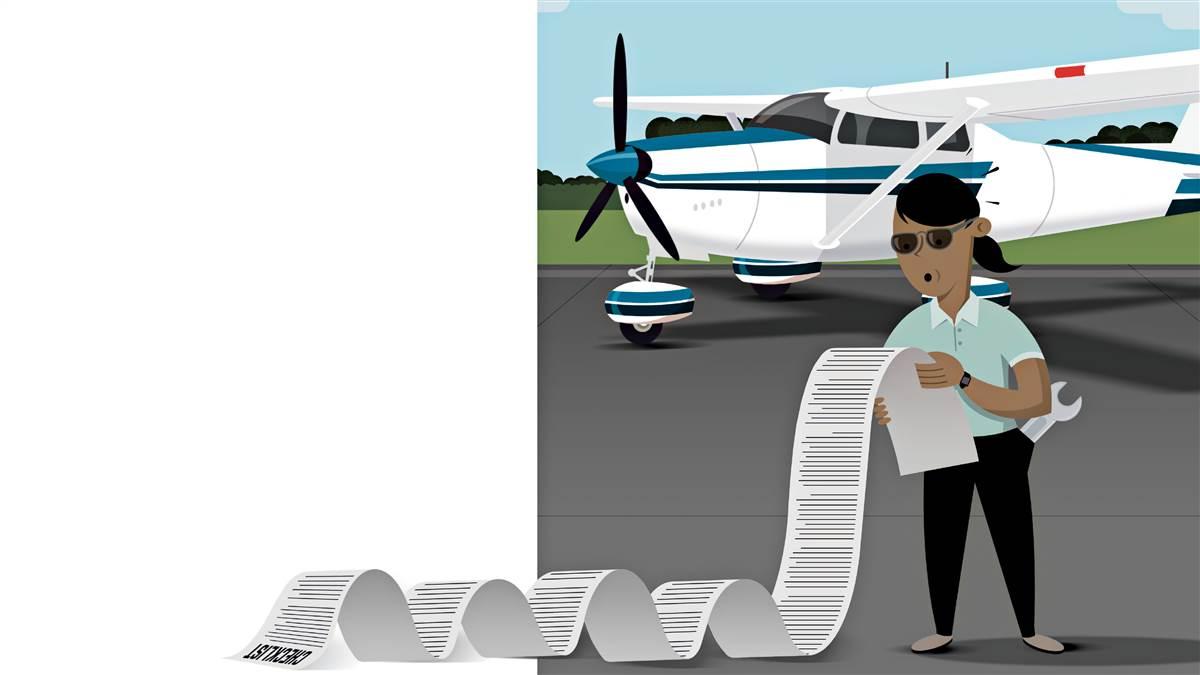Keeping 'em flying
Airworthiness for pilots

The primary latch pin on the seat roller housing had failed, letting the seat roll freely back on the rails rather than holding the seat locked firmly in place as the pin was designed to do. It all happened too fast to give me the heart attack it deserved.
I was lucky. Keith Harper was not. The same thing happened to him in his Cessna 172 while taking off from the Cape May County (New Jersey) Airport on June 2, 1980, resulting in a departure stall that killed him and two of his three passengers. His accident, and a number of others—some fatal, some not—led to the 1987 issuance of an airworthiness directive, commonly called an AD, that eventually would require inspection and repairs to seat rollers, pins, and rails in 36,000 airplanes in the United States.
So just what is an AD?
At their core, ADs are the FAA’s way of correcting a wide variety of safety issues in airplanes that develop after manufacture. Sometimes long after manufacture. ADs are more than just best practices or good ideas. They are the law. Under FAR Part 39, ADs are “legally enforceable rules” issued by the FAA to correct an unsafe condition in a product. This regulation defines products—for the purposes of ADs—as aircraft, engines, propellers, or appliances (think instruments). So pretty much every part and parcel of an airplane.
An AD calls out a safety issue and spells out the corrective action required to fix it: special inspections, repairs, or alterations. A time window for corrective action usually is part of the AD, as well.
So just how do these ADs come about? How many kinds are there? How do you find out if there are ADs on the airplane you are flying? And what are your responsibilities as a pilot when it comes to ADs?
Why an AD?
While it’s debatable what the intended design life of our GA airplanes was to begin with, you only need to look to the warbird community to see that, properly cared for, airplanes are eternal. That said, our GA fleet is in its upper middle age, with many training airplanes older than the student pilots flying them. Over time, corrosion and metal fatigue, among other things, can take their toll, and even well-maintained aircraft can develop issues that, if not corrected, can make flight dangerous.
ADs are designed to keep us safe by looking for problems that develop in the fleet, and requiring action to—basically—head off trouble at the pass.
The Process
I won’t bore you with the details of the process but generally speaking, if the FAA suspects, based on reports of safety issues, that an AD is required, the agency publishes a notice of proposed rulemaking (NPRM) to solicit public comment from affected parties—pilots, owners, manufacturers, flight schools, and more—then ultimately issues what’s called a final rule that establishes the AD. An exception to this process is the emergency airworthiness directive, or EAD, when the FAA determines that an unsafe condition requires immediate action, such as the FAA’s grounding of Boeing 787s following a pair of internal lithium-ion battery fires.
Once a final rule is issued, the AD literally becomes part of the federal aviation regulations. For analogy, if the FARs were the U.S. Constitution (God forbid), ADs would be amendments to the constitution. So just how many amendments to the FAA’s constitution are there? The FAA’s website currently lists more than 15,000.
Some of the ADs are simple and cheap to take care of. Others are frighteningly expensive (see “On Your Side,” p. 42). The Cessna seat rail AD is an $85 inspection. On the other hand, compliance with an AD affecting ECi cylinders used on more than 6,000 Continental engines cost owners an estimated $11,500 per engine.
So where do the safety concerns that generate ADs originally come from? They can originate with manufacturers, holders of supplemental type certificates, foreign authorities (aviation is global), Service Difficulty Reports from mechanics or owners, notifications from type clubs, and—sadly—from National Transportation Safety Board investigations. For example, when an AT–6F lost its wing in flight in 2005, crashing and killing two, it resulted in AD 2005-12-51, requiring inspections of the wing attach angles on virtually all T–6s.
The nuts and bolts of an ad
Once issued, an AD might apply to all aircraft of a make and model; to airplanes in a certain serial number range; or to specific engines, propellers, or instruments that might be installed on a variety of airframes. ADs may require a simple inspection, a replacement, or a modification. Some are one-off, requiring a single one-time inspection or repair, while others are periodic, requiring ongoing inspections based on calendar time, time in service, or both.
Recurring ADs, like airplanes themselves, are eternal unless they are suspended by a subsequent AD or have a terminating action, such as a cylinder removal or replacement.
Who’s responsible for an AD?
Legally, the owner and operator of an airplane is responsible for ensuring that all ADs are compiled with, and while—in most cases—an FAA-certificated mechanic must complete the work and sign off in the airframe, powerplant, or propeller logs that it was complied with, the buck stops with the pilot in command. FAR 91.103 requires us to become familiar with “all available information,” and FAR 91.7 requires us to ensure that any airplane we fly is in airworthy condition; and an airplane that is not in compliance with an AD is technically not airworthy (see “Flyable versus Airworthy,” page 40).
What happens if you don’t comply?
Noncompliance with an AD is a violation of the FARs. FAR 39.7 states that anyone who operates a product that doesn’t meet an airworthiness directive is in violation of the regs, and enforcement action can be taken. Furthermore, each flight out of compliance is a separate violation, so they can pile up. Fines can be imposed, and certificate action can be taken against the pilot if he or she flies an unairworthy aircraft.
An airplane out of compliance with an AD loses its airworthy status, so in addition to the fact that it can’t be legally flown, it might lose its insurance coverage if it is. ADs are serious business.
So where do I find an AD?
The FAA website maintains a database, searchable by make and model, of all current and historical ADs back to 1943. Compliance with ADs needs to be recorded in the aircraft’s logbooks, and in many cases can be found in an AD log sheet or compliance table. The log sheet is especially useful to ensure timely compliance with recurring ADs. Just because an airplane is “in annual,” doesn’t necessarily mean its ADs are up to date, as some are based on flight hours rather than calendar dates. A good log sheet saves flipping through endless pages of maintenance records to ensure compliance.
AD 2018-03-03 R1, affecting 2,147 Cessna twins,is a required inspection of the carry-through spar cap that originated with the discovery of a “fully cracked” spar cap on a 402C. The inspection required by the AD is estimated to cost $1,020.If repairs are required, the cost is estimated at a whopping $73,000.But that’s not all you should be aware of when becoming familiar with all available information.
Cousins
The kissing cousin of the AD is the SB, or service bulletin. Rather than originating with the FAA, SBs come from the manufacturer of the airplane, engine, propeller, or “appliance.” For most Part 91 aircraft, service bulletins are optional from a legal perspective, even if labeled as “mandatory” by manufacturer. Legally, the FAA requires compliance only with ADs, but aircraft owners should be aware of service bulletins, evaluate them, and discuss them with their mechanic.
There also are documents called SAIBs, special airworthiness information bulletins. Issued by the FAA, they provide nonmandatory information regarding airworthiness “concerns” that don’t rise to the level of an unsafe condition requiring an AD, and they often align with manufacturer service bulletins. Additionally, the FAA issues airworthiness concern sheets to gather input from operators early in the process of developing an AD.
AD 2018-07-03, affecting 17,957 Piper PA–28 models, mandates the change of fuel tank selector placards in some airplanes, which apparently were installed backwards in an unknown number of Piper airplanes, causing a fuel starvation risk, according to the FAA. The AD allows private pilots to check the placards as part of a preflight, and if they need to be replaced, the estimated average cost to owners for compliance is $42.50 per airplane.It could have been much higher. The FAA’s original proposed AD did not allow private pilots to check. The FAA pushed back the compliance deadline three times to accommodate alternative method of compliance (AMOC) requests from AOPA that saved owners more than $763,000 in labor costs.Maintenance savvy
As an airplane owner I’m sometimes exasperated by the time and expense of ADs, but as a pilot I’m grateful for them. After all, most of the airplanes in the GA fleet are oldies but goodies. As such, as they age, unexpected problems come up. From my perspective, it’s nice to know that someone has my back, looking for problems and helping me and my mechanic head them off at the pass. But owner or not, all pilots need to be smart about ADs for two reasons. First, hey, it’s the law. And second, it’s just “plane” smart.

 On your side
On your side